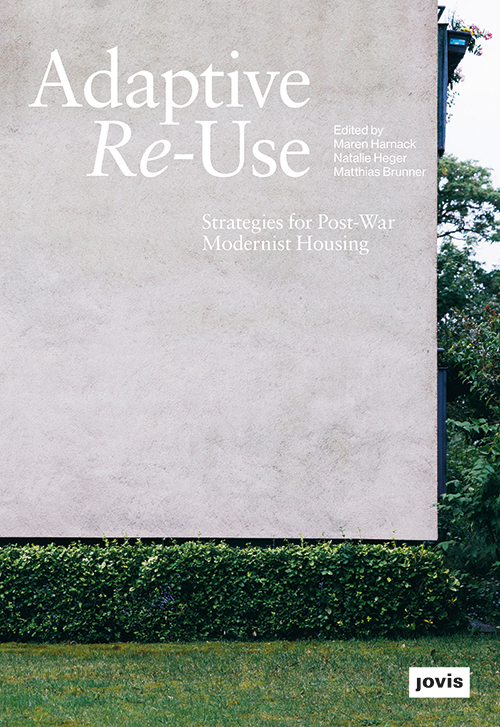Adaptive Re-Use
Adaptive Re-Use: Strategies for Post-War Modernist HousingMaren Harnack, Natalie Heger, Matthias Brunner (Editors)Jovis, April 2021Paperback | 6-1/2 x 9-1/2 inches | 144 pages | 60 illustrations | English | ISBN: 9783868596113 | 29.80€PUBLISHER'S DESCRIPTION:In prosperous regions, housing markets are under significant pressure. With the focus on preserving land and developing brownfield sites, post-war housing estates are being earmarked for densification, as their density is perceived as rather low and the ownership is often concentrated in the hands of only a few publicly owned housing associations. In this setting, post-war estates are in danger of losing their characteristic spatial structures and landscaping.Adaptive Re-Use discusses strategies for the development of post-war housing by referring to European case studies from the period of 1945 to 1975. The contributions in this edited volume show how housing estates from different European countries are listed and preserved, and how architectural fabric can be adapted to meet today’s needs.REFERRAL LINKS: dDAB COMMENTARY:The New York City neighborhood where I live is one of many that has been rezoned by the Department of City Planning in recent years. So residential streets with row upon row of two-story buildings, for instance, are seeing more and more of them either added to or torn down and replaced with three- or four-story buildings. To me, climate change and global warming point to additions rather than demolitions, but whatever the approach, and given the city's housing shortage — affordable and otherwise — rezonings make the most sense when the additional bulk leads to more apartments and therefore more families. But that's not always the case, with the extra square footage often being created for larger residential units rather than additional ones.What does my neighborhood in Queens and its many pre-war houses and apartment buildings have to do with "strategies for post-war modernist housing" in Britain, Germany, Switzerland, and other European countries, as explored in the twelve essays in Adaptive Re-Use? For one, the same issue happening here is found there, but with different details. In their contribution, "The Crux of Inward Development," Stefan Kurath and Simon Mühlebach build upon their earlier publication, Stadtlandschaften verdichten, that argued for an approach of urban densification in post-war neighborhoods. They realized in the interim that urban densification "destroys (affordable) housing," finding that "a denser built fabric does not always result in more apartments." Without regulations in place mandating that more density results in more residents, the opposite has been happening, with one- and two-person households, for example, living in units meant for large families.Adaptive Re-Use came out of the conference of the same name that took place at the Frankfurt University of Applied Sciences on October 11, 2019, organized by the Post-War Modernist Housing Research Lab. The first half of the dozen contributions, as the editors explain in their introduction, "focus on discussing fundamental issues around listing and preserving post-war modernist neighborhoods." Here is where the essay on inward development mentioned above is found, as well as one on the selection of listed projects in Britain and one on the importance of knowing historical construction methods, among others. These contributions are nuanced contextual takes on a well-defined subject with many complex layers.The second half of the book hones in on specific projects that were "selected for their remarkable preservation and development strategies." These include the replacement of the student housing complex at Munich Olympic Village, the preservation of Alvaro Siza's famed Bouça Housing Complex, and Bremer Punkt, an urban infill project in Bremen, Germany. While you won't find Lacaton & Vassal's high-profile, award-winning Transformation of 530 Dwellings - Grand Parc Bordeaux, the book does have DeFlat Kleiburg, which gained some attention as the first housing project and renovation given an EU Mies Award, back in 2017. Although architects and projects of note are found throughout Adaptive Re-Use, the contributors appear to see the lessons learned as applicable to projects well beyond the architecturally exceptional — thereby achieving that much more good in the future.SPREADS:

Maren Harnack, Natalie Heger, Matthias Brunner (Editors)
Jovis, April 2021
Paperback | 6-1/2 x 9-1/2 inches | 144 pages | 60 illustrations | English | ISBN: 9783868596113 | 29.80€
PUBLISHER'S DESCRIPTION:
REFERRAL LINKS:
SPREADS:









